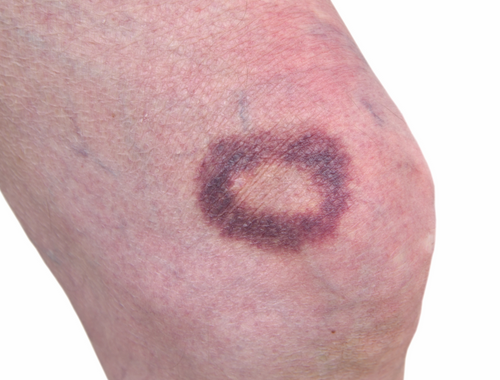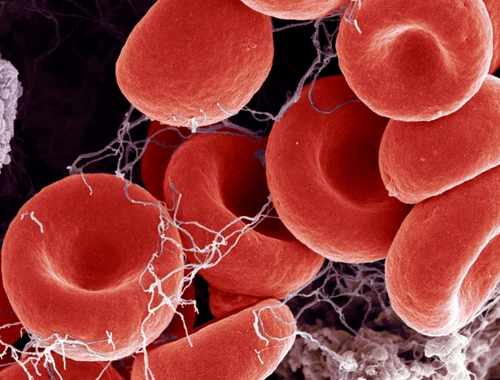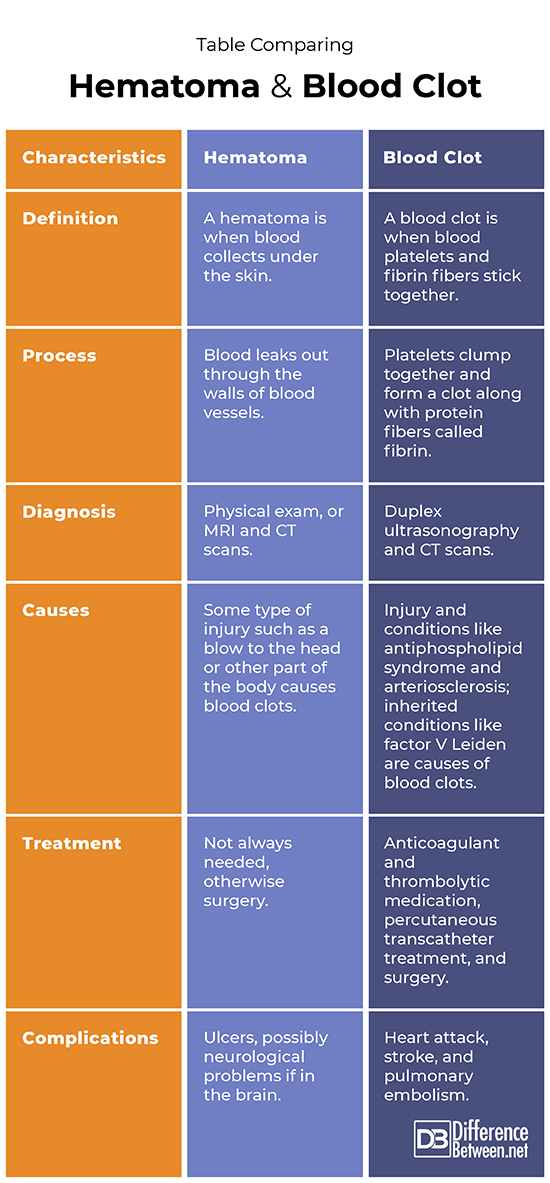Difference Between Hematoma and Blood Clot
A hematoma is when blood amasses under the skin or in an organ where there has been an injury. A blood clot is a mechanism in which platelets stick together and join with fibrin to stop bleeding.

What is Hematoma?
Definition:
A hematoma is an accumulation of blood under the skin that may contain some blood clots.
Causes:
A hematoma often is caused by some type of injury causing blood vessels to leak blood. Minor and more serious injuries where there has been a blow to the body can result in hematomas.
Symptoms and complications:
The symptoms of a hematoma vary depending on where it occurs. Often there is pain and swelling and a discolored purple-colored area can be seen on the skin over the injury. A small hematoma is usually not a problem. However, a large hematoma can cause ulceration. A hematoma on the brain can cause symptoms such as headache, dizziness, and confusion, and can cause death if it is bad enough.
Diagnosis:
A small hematoma under the skin is diagnosed by a physical exam. Hematomas on internal organs such as in the brain are diagnosed using imaging methods such as MRI and CT scans.
Treatment:
For some hematomas, no treatment is needed. But any hematoma in the brain, for instance, a subdural hematoma, needs to be carefully observed and may require surgical intervention.

What is a Blood clot?
Definition:
A blood clot is when platelets clump together and combine with fibrin.
Causes:
The cause of a blood clot is some type of injury requiring that bleeding is stopped. It is often a normal part of physiology meant to stop us from bleeding to death. However, there can be pathological blood clots. In other words, clots form when they shouldn’t. Conditions such as antiphospholipid syndrome and arteriosclerosis can cause blood clots, as well as genetic conditions like factor V Leiden.
Symptoms and complications:
Abnormal blood clots cause symptoms when they occur. They can cause strokes and heart attacks if they lodge in the brain or heart. Blood clots in the leg are called deep vein thrombosis (DVT) and can cause pain, redness, and swelling. A DVT is dangerous because the clot can break off and travel to the lung causing a pulmonary embolism (PE) which can be deadly.
Diagnosis:
A DVT can be diagnosed by duplex ultrasonography. A CT scan is used to diagnose a stroke caused by a blood clot.
Treatment:
Treatment depends on where the clot is. Anticoagulants and thrombolytics are medications that can be used to get rid of blood clots. Antiplatelets like aspirin are also used. Percutaneous transcatheter treatment is when a catheter is threaded through a vein to where a clot is. This then is used to break up the clot. In some cases, surgery is needed to remove clots.
Difference between Hematoma and Blood clot?
Definition
A hematoma is when blood collects under the skin. A blood clot is when fibrin and platelets stick together.
Process
A hematoma happens when blood leaks out of blood vessels. A blood clot happens when there is binding of platelets and fibrin.
Diagnosis
A hematoma can be diagnosed by a physical exam or MRI and CT scans. Duplex ultrasonography and CT scans are used to diagnose blood clots.
Causes
The cause of a hematoma is some type of traumatic injury. The cause of a blood clot is a tear in a blood vessel which can be due to trauma, but also certain conditions like anti-phospholipid syndrome or factor V Leiden.
Treatment
In the case of a hematoma, treatment is not always needed; surgery may be needed for brain hematomas. In the case of a blood clot, blood thinner medications such as antiplatelets and anticoagulants can be used.
Complications
Possible complications of a hematoma include ulceration, and if in the brain it can cause neurological damage. Possible complications of a blood clot include heart attack, stroke, and pulmonary embolism.
Table comparing Hematoma and Blood clot

Summary of Hematoma Vs. Blood clot
- A hematoma and a blood clot are both conditions related to blood.
- A hematoma is a collection of blood under the skin.
- A blood clot is the body’s way to stop bleeding but can be pathological and cause health problems.
FAQ
What does a hematoma look like?
A hematoma is an accumulation of blood under the skin after some kind of injury.
How do you know if you have a hematoma?
It depends on where a hematoma is located but often the skin is purple and discolored in the region of the hematoma. Hematomas in the brain have different symptoms such as headache and confusion.
What can be mistaken for a blood clot?
Several conditions can be mistaken for a blood clot, namely, varicose veins, peripheral artery disease, and cellulitis.
Does a blood clot hurt when touched?
It depends on where a blood clot is located but it can cause pain and edema and you may feel a lump under the skin if it is close to the surface.
How does a blood clot feel?
It depends on where a blood clot is. If it blocks a carotid or coronary artery you could experience symptoms of a stroke or heart attack, while a DVT causes pain in the leg, and a PE, causes breathing problems.
- Difference Between Rumination and Regurgitation - June 13, 2024
- Difference Between Pyelectasis and Hydronephrosis - June 4, 2024
- Difference Between Cellulitis and Erysipelas - June 1, 2024
Search DifferenceBetween.net :
Leave a Response
References :
[0]Cleveland Clinic. “Subdural hematoma”. Cleveland Clinic, 2022, https://my.clevelandclinic.org/health/diseases/21183-subdural-hematoma
[1]Goldhaber, Samuel Z., and Nicole Grasso-Correnti. "Treatment of blood clots." Circulation 106.20 (2002): e138-e140.
[2]Mao, Gordon. “Intracranial hematomas”. Merckmanuals. Merck & Co., 2022, https://www.msdmanuals.com/home/injuries-and-poisoning/head-injuries/intracranial-hematomas
